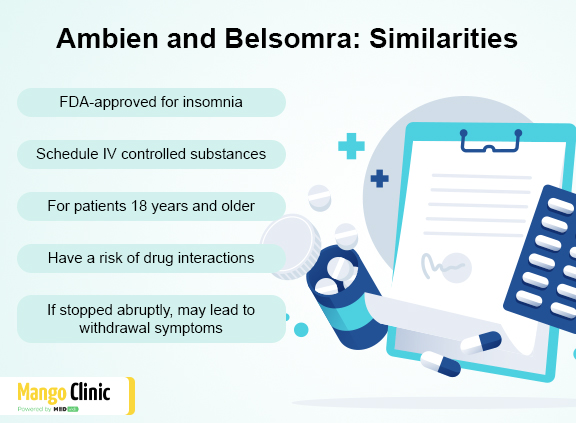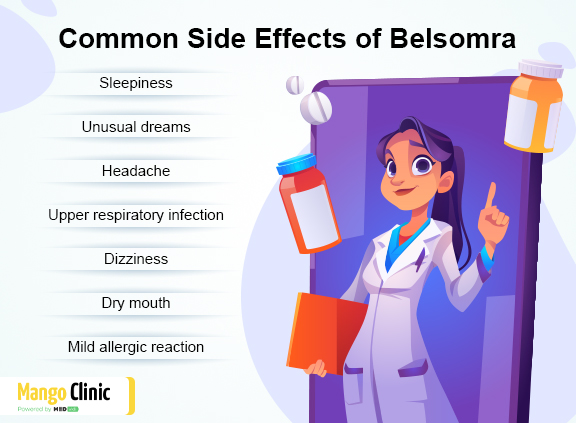Belsomra vs. Ambien: Similarities and Differences

Insomnia is a prevalent sleep disorder that makes it difficult to fall asleep, sleep through an entire night, or have quality sleep. In the United States, approximately 25% of adults experience acute insomnia, while 10% to 30% struggle with a chronic sleep disorder. Patients use different treatment and management techniques to improve sleep quality and patterns. In persistent insomnia cases, prescription drugs are required to manage the condition.
Belsomra and Ambien are common and effective prescription medications to treat insomnia. Belsomra is a Merck product, while Sanofi-Aventis makes Ambien. Various manufacturers also sell Ambien as Zolpidem, a generic. Although both drugs treat insomnia, they are not similar. In this post, let’s review their similarities and differences.
Untreated insomnia can affect a person’s mental and physical health. Get help today.
What is Belsomra?
Belsomra was approved in 2014 under the generic name, Suvorexant. The drug is classified under the orexin receptor antagonists group of medicines. Belsomra blocks the binding of orexin A and orexin B neuropeptides to orexin receptors. This action suppresses wakefulness and helps a person fall asleep fast. The oral drug takes effect after 30 minutes of intake and lasts in the body for several days.
What is Ambien?
FDA approved Ambien in 1992, and it has been in the market for several years as a Zolpidem generic. The drugs are classified under the sedative-hypnotics medicine group. Ambien slows down brain activity to enable a person to sleep. The medicine takes effect 30 minutes after intake and stays in the body for about eight to ten hours.
Zolpidem is also available in the following brand forms:
- Ambien CR (controlled release)
- Edluar (sublingual tablets or under-the-tongue tablets)
- Intermezzo (sublingual tablets, fast-acting low dose)
- Zolpimist (oral spray)

Ambien vs. Belsomra: Similarities
Since both Belsomra and Ambien treat the same condition, they are bound to have some similarities, including the following:
- FDA Approval
FDA has approved both medications as sleep aids drugs.
See a mental health expert to get a prescription for insomnia medications online.
- Have DEA-controlled status
Both sleep aids have a potential for misuse and addiction, hence their classification as schedule IV controlled substances.
- Approved age
The medications are approved for adult use only. A child under 18 years cannot take Belsomra or Ambien to treat insomnia.
- Drug interactions
Both drugs negatively interact with specific chemical substances such as Azole antifungals, Rifampin, and seizure drugs.
- Withdrawal symptoms
When a person stops to use either of the two drugs, withdrawal symptoms are likely to occur. Following the doctor’s instructions is crucial to avoid the risk of severe side effects.
- Intake schedule
The drugs are taken once per day and thirty minutes before bedtime.

Belsomra vs. Ambien: Differences
Though both Belsomra and Ambien treat insomnia, they have significant differences. These variances are:
| Belsomra | Ambien | |
| Working mechanism | Belsomra drug class is an orexin receptor antagonist that blocks orexin’s activity to improve sleep quality and duration. | Ambien is a sedative-hypnotic that activates the Gamma-aminobutyric acid (GABA) neurotransmitter to slow down the central nervous system (CNS) and brain activity to help a person fall asleep quickly. |
| Standard dosage | Belsomra dosage: tablets of 5mg, 10mg, 15mg, and 20 mg. The recommended dose is 10mg, taken 30 minutes before bedtime. If need be, a doctor may increase the quantity to a maximum of 20mg. | Ambien tablets are 5 mg and 10 mg, while Ambien CR tablets are available in 6.25 mg and 12.5 mg. Women take a 5 mg tablet, whereas men take a 5 mg or 10 mg dose. The tablet is taken orally 30 minutes before bedtime. Ambien’s maximum dose is 10 mg. |
| Generic brands | There is no Belsomra generic. | Ambien has generic forms that are in line with the standard Ambien medicine: an oral spray, pills, and sublingual tablet |
| Side effects | Belsomra side effects include abnormal dreams, cough, infection of the upper respiratory tract, and drowsiness, among others. Patients report that Belsomra leaves them too drowsy to drive the next day. | Ambien’s side effects include constipation, stuffy nose, nausea, euphoria, sore throat, lightheadedness, diarrhea, dizziness, dry mouth, and loss of coordination and balance. |
Can Belsomra and Ambien Be Used Together?
The two medications should not be taken together. Mixing the drugs will not help a person sleep better. Instead, it will increase the likelihood of adverse side effects. Doctors do not prescribe these medications concurrently due to the potential negative impact on a person’s health.
Conclusion
Both Belsomra and Ambien are effective insomnia treatment medicines, and the doctor will choose the most suitable one for you based on your symptoms, health history, and medication history. However, they are better used for a short period because they can cause dependence. The medications have varied side effects depending on the individual. Consult the doctor for a review if the medicine is not effective or in case of severe side effects.









